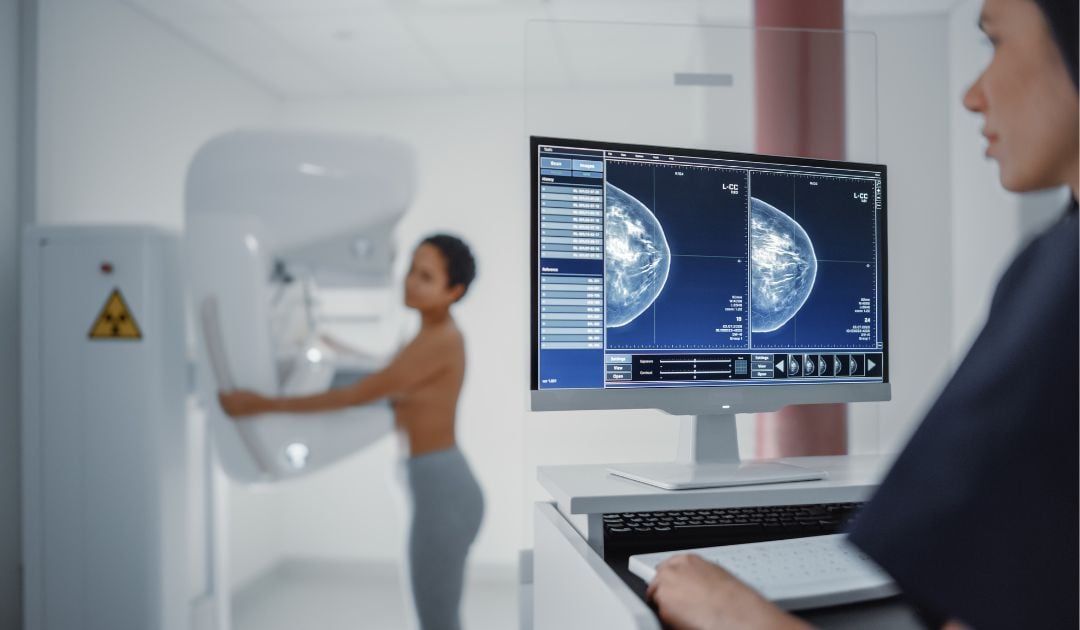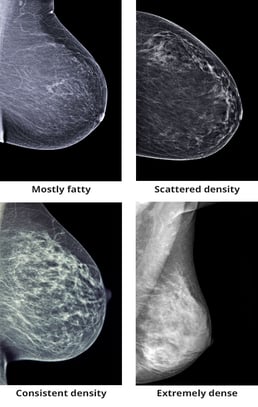
If you recently had a mammogram and were told you have dense breasts, you probably have some questions about what this means and how it affects your breast cancer risk and future exams. It's important to know that dense breast tissue is common and may never cause additional problems.
What Does it Mean to Have Dense Breasts?
Breast density is a term used to describe the types of tissue that make up your breasts. Simply put, dense breasts have more connective and breast (glandular) tissue than fatty tissue. These different types of tissue show up differently in the images created during a mammogram. Connective tissue makes it difficult for a doctor to determine whether you have any tumors. Therefore, you may be required to have additional testing for doctors to get a better view and an accurate screening for breast cancer.
What Causes Dense Breasts?
While there are a number of factors that may cause dense breast tissue, there is nothing you can do to prevent it. Your breast density comes from a combination of your genetic makeup and your age. Breast density can even change over time, and breast tissue often becomes less dense as you age. Here are the most common reasons women have dense breasts:
- Age: Approximately 50% to 60% of women aged 40-44 have dense breasts, as opposed to 20% to 30% of women aged 70-74.
- Weight: About 50% to 60% of healthy-weight women have dense breasts compared to 20% to 30% of obese women.
- Medications: Hormones can affect your breast density. Women who take menopausal hormone therapy (MHT) have denser breasts than normal because MHT slows the process that makes breasts less dense. Tamoxifen reduces density and is sometimes used for risk reduction.
- Family history: Dense breasts can be inherited.
Breast Density Types
 There are four categories of breast density ranging from almost all fatty tissue to very dense tissue with minimal fat. The radiologist who reads your mammogram will determine which category best describes your breasts. These are the four breast density categories:
There are four categories of breast density ranging from almost all fatty tissue to very dense tissue with minimal fat. The radiologist who reads your mammogram will determine which category best describes your breasts. These are the four breast density categories:
- Mostly fatty: Breasts are made up of almost all fatty tissue, making abnormalities easy to detect on your mammogram. (Found in about 10% of women.)
- Scattered density: Breasts are composed of mostly fatty tissue. However, scattered areas of dense tissue exist. (Found in about 40% of women.)
- Consistent (heterogeneous) density: The breasts have mostly dense tissue evenly distributed throughout the breasts. This can make it difficult to detect small tumors around the dense tissue. (Found in about 40% of women.)
- Extremely dense: Breasts are extremely dense, making mammograms difficult to read since tumors aren't visible around dense tissue. (Found in about 10% of women.)
Your mammogram report will include an assessment of masses, lumps, distorted structures, or calcifications found in the breasts, as well as an assessment of breast density. After a radiologist reviews your images, your doctor will discuss the results with you and recommend more tests if necessary.
In March of 2023, the Food and Drug Administration (FDA) amended the Mammography Quality Standards Act (MSQA) of 1992, which requires your doctor to disclose information regarding the density of your breasts. By September 2024, all mammogram reports sent to patients in the US will be required to include breast density described as either “not dense” or “dense”. Having this information will allow you to have conversations with your doctor about your specific risk for breast cancer.
The Connection Between Dense Breasts and Breast Cancer
Dense breasts affect your cancer risk in two main ways:
- Dense breasts put you at a higher risk for breast cancer.
- Tumors are difficult to see with traditional screening tests.
Studies have shown that women with dense breast tissue are four to six times more likely to develop breast cancer than those with mostly fatty breast tissue. This risk increases with the amount of dense tissue found in your breasts. While the reason for the connection is currently unknown, it's important to remember that breast density alone does not determine breast cancer risk. It is only one of the many risk factors related to breast cancer.
Tumors can often go undetected in women with dense breasts because small areas of cancer can hide behind the dense breast tissue, appearing the same color on the mammogram. It's widely known that early detection of breast cancer is a vital step in successful treatment. Therefore, your doctor may suggest you have additional tests if you have extremely dense breast tissue.
How Dense Breasts Affect Your Mammogram
Breast density isn't something you can feel or diagnose on your own. It must be determined by a mammogram. The fatty breast tissue appears dark on mammogram images. Dense or fibrous tissue appears white. This is an effective way to determine breast density, but tumors and other abnormalities also look white on your mammogram. This similar appearance makes abnormalities difficult to detect.
Mammograms are still considered the most effective way to screen for breast cancer. The test is performed by a mammogram technologist (mammographer). When the mammogram is complete, the images are reviewed by a radiologist. After your breast density is determined, your doctor can decide if you need additional tests.
Additional Screening for Women with Dense Breasts
It's important to talk with your doctor about the best screening plan for your personal situation. Your doctor will consider your risk factors and protective factors that may lower your chance of breast cancer before recommending further tests. Common imaging tests include:
- 3-D Mammography (breast tomosynthesis): Tomosynthesis uses several images to create a 3-D image of the breast instead of the 2-dimensional image created by a traditional mammogram.
- MRI: A breast MRI uses radio waves and strong magnets to create detailed images of the breast. This test may be recommended for women who have already been diagnosed with breast cancer to determine the size of the tumor or as a part of a screening plan for women at high risk for breast cancer.
- Ultrasound: Breast ultrasound uses sound waves to take images of the breast. An ultrasound is a non-invasive test that may be used after an abnormal mammogram.
Dense breasts are only one risk factor for breast cancer. However, increased breast density can make your screening mammograms more difficult to read. Understanding your risks for breast cancer is an important way to help your doctor detect abnormalities. If you have questions about breast density, you need to talk with your doctor about your personal risks. Discussing your options for additional screening can help you detect abnormalities and tumors before they become aggressive.




